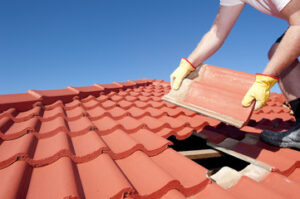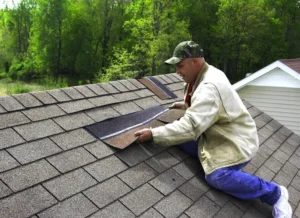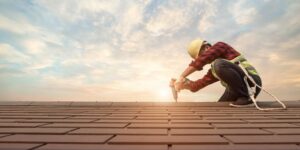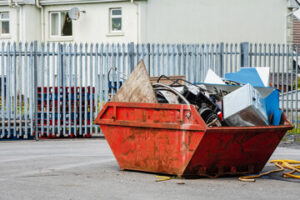Sarasota Roof Cleaning provides an energy-efficient barrier between a home and the outdoors. It can prevent costly moisture damage and mold.
Professional cleaning companies use low to moderate water pressure and cleaning solutions to remove growths, stains, and streaks. They may also apply a safe biocide to inhibit future moss and lichen growth.

Roofs can be very slippery and dangerous if you’re not careful. A fall from a roof can lead to serious injury or even death. That’s why following safety measures when cleaning your roof is important. You should also keep in mind that the cleaning solution used on a roof can be corrosive to metal gutters and downspouts. So, it’s essential to rinse off the gutters and downspouts after each use of the cleaner.
When cleaning your roof, it’s important to use a ladder that is well-secured to the building and is tall enough for you to work comfortably on. It’s also a good idea to use a ladder standoff device to help stabilize the ladder when you climb up and down it. Also, be sure to wear shoes with strong grip and traction to reduce the risk of slipping.
If you’re using a pressure washer to clean your roof, make sure to use a low setting and keep it away from the edges of the roof. A high-pressure water spray can cause damage to the shingles, and it’s also not good for the environment. You should also avoid using any cleaning chemicals that are toxic to plants or animals.
Before starting the roof cleaning process, it’s important to make sure that the weather is clear and dry. Moisture and humidity can prevent the cleaning solutions from being effective and can also increase the risk of accidents. It’s also important to choose a day when the wind isn’t blowing too hard.
The first step of cleaning your roof is to remove any large clumps of moss that are growing on it. This can be done by hand or with the help of a hose. Next, you should apply a biocide to the surface of the roof to kill any fungus, algae, or moss growth that’s been growing on it for a long time.
When the fungus, algae, or moss is killed, it won’t grow back and will help keep your roof in good shape for longer. Then, you can proceed to cleaning the rest of your roof.
There are a few pieces of equipment that every roof cleaner needs to have on hand when they’re cleaning a roof. These include safety equipment like a harness and a fall arrest system, as well as protective eyewear, boots, gloves, and other gear to keep the cleaner safe while they work.
A good quality pressure washer is essential for getting rid of dirt, moss, and other debris from the surface of the roof. The best power washers on the market are made of stainless steel and are easy to use for anyone who has had a little practice. They also have a variety of spray attachments for different purposes, so you can find the one that’s right for your job.
For those who prefer a less aggressive approach to cleaning their roof, there are eco-friendly cleaners available. These cleaners are much safer for kids, plants, and any wildlife that may be roaming around the property. They can still get the job done when it comes to breaking down dirt, mold, and mildew, but they’re not as harsh on the roofing material as their chemical counterparts.
There are two main methods to clean a roof: pressure washing and soft washing. Pressure washing uses highly pressurized water to remove moss, stains, and other debris from the roof, while soft washing is an environmentally friendly method of cleaning that can be used on more delicate roofing materials such as shingles.
If you’re going to be using a pressure washer, you’ll need some extra equipment to help you apply the cleaning chemicals. A backpack sprayer is a great option for applying the chemicals, as it’s easier on your hands than a hose reel. It’s also more mobile, so you can easily reach those hard-to-reach spots on the roof.
Another helpful piece of equipment is a chemical mixing system. This can help you save time and money by eliminating the need to calculate the chemical concentration for each project. It can also make the transition between projects seamless, so you don’t have to worry about wasting chemicals when switching jobs. The ProPortioner is a chemical mixing system that’s specifically designed for contract cleaners to help increase efficiency and reduce downtime.
The most common chemical used when cleaning a roof is bleach. It kills organic matter like Gloeocapsa Magma algae, mildew, and moss and lichen growth on roofs. But bleach alone does not clean the surface of a roof or siding. It needs help to do its job, such as surfactants that help it penetrate deeply and stay on the surface longer so it can kill organisms at their roots.
Bleach is also highly alkaline, which damages asphalt shingles and erodes concrete. If used incorrectly, it can damage the roof and void its warranty. A soft washing contractor should know this and use the lowest concentration of cleaning chemicals possible.
Other chemicals used when soft washing a roof include surfactants, fungicides, and algaecides. They can be diluted with water and applied using a brush, sprayer, or power washer. The chemicals help break down organic stains and remove spores, allowing the bleach to kill them. They also help the bleach penetrate deep into the surface of a roof or siding and eliminate any residual contamination left behind by other organisms, such as sand or dirt.
Most soft wash contractors will use a professional-grade 12.5% solution of sodium hypochlorite, or bleach, in a solution with a surfactant to clean the surface of a roof and remove organic growth. This is typically a safe and effective solution for most roofs, but it is not the only one that professionals can use.
Another option contains quaternary ammonium and isopropyl alcohol. This biodegradable product can be diluted with water and is a great choice for removing moss, lichen, and algae staining. It is also safer and more effective than bleach.
The debris that accumulates on your roof, especially if it’s overgrown with leaves, twigs and branches, is more than just an eyesore. Organic matter promotes the growth of moss and algae, which retain moisture that damages shingles. If left unchecked, moss can rot the shingle and allow water to leak into the home. It can also void some roofing warranties, according to the Asphalt Roofing Manufacturers Association.
One roof-cleaning option involves directing high-pressure water at mold, mildew and dirt to blast them away. However, this can damage shingles and even cause them to fall off. It’s best used for metal or tile roofs and at a low psi setting to avoid damaging the surface.
Chemical-free roof cleaning is another method that uses less power and psi to remove stains. Some products are designed to work overtime to lighten stains. The chemicals don’t contain chlorine bleach or phosphates, which protect landscaping under the roof and save the shingles from wear and tear. This method also reduces the risk of animals ingesting the cleaner, which is important if you have pets and children in your yard.
Many homeowners choose this option because it’s safe for the environment and for their homes. Other nontoxic options include Wet and Forget, which works over a long period of time to lighten dark stains. Other cleansers have different cleaning powers, for example one is good for grease stains while the other is better for mildew and mold.
If you decide to use a bleach cleaner, make sure the contractor knows up front that you don’t want them to rinse the bleach off your home’s exterior, as this can void some roofing warranties. Then, ask them to use a product that doesn’t require rinsing, such as Star Brite Mold and Mildew Stain Remover.
The best option for homeowners is to hire a professional roof cleaning service. A company that offers this service will be able to determine how much moss has grown on your roof and how severe the damage is. They can also help you find a solution that will eliminate the moss without removing the underlying shingles or damaging the landscaping underneath.






